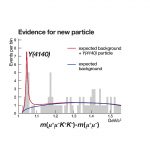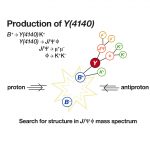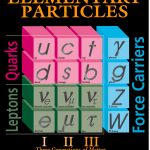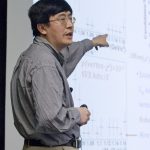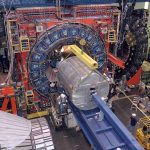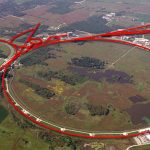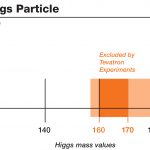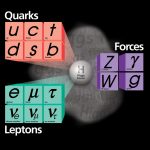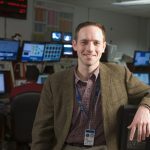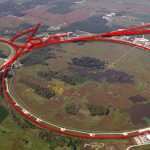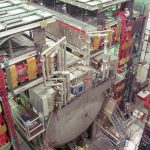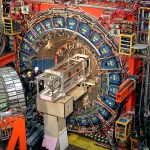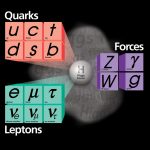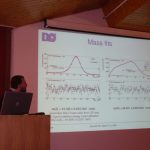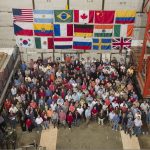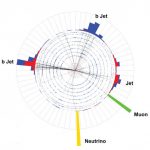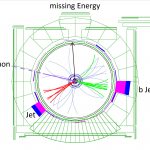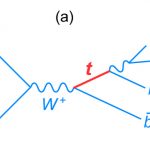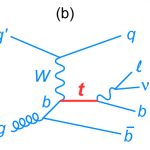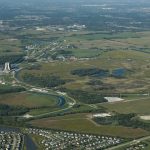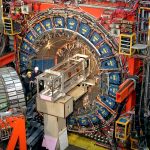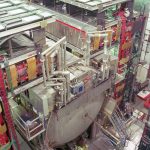This isn’t your average field trip. This month, more than 6,000 high school students participating in Hands-on Particle Physics Masterclasses will have the chance to form national or international scientific collaborations, just like real particle physicists do.
With the help of particle physicists, about 400 students from across the United States will analyze data from large particle collider experiments at CERN, the European Center for Nuclear Research. Most students will participate in this activity at universities and research institutes near their schools.
Classroom groups will discuss their findings via videoconference with other groups of students from across the country or across the globe. Physicists at Fermi National Accelerator Laboratory, including the laboratory’s deputy director, Young-Kee Kim, will help moderate videoconferences.
“This is a great opportunity to give students a deeper understanding of particle physics,” Kim said. “I hope this program will inspire them.”
This year high school students from around the world will participate in the international Hands-on Particle Physics Masterclass program, which began in Europe in 2005 and has expanded into the United States, South Africa and Brazil. Scientists at more than 100 universities and laboratories in 23 countries, including 22 institutions in the United States, will host students.
Students in the United States will participate through QuarkNet, a national program that unites high school students, physics teachers and particle physicists.
The opportunity to experience state-of-the-art research in an authentic environment will give students insight into the international organization of modern research. At the same time, they will learn about the building blocks of our universe through presentations by scientists involved in particle physics research.
“The Masterclass gives students the opportunity to understand the way physicists do high-energy physics,” said Jeff Rylander, instructional supervisor for the science department at Glenbrook South High School in Glenbrook, Ill. Rylander brought eight of his students to Argonne National Laboratory for a Masterclass last year and worked with a particle physicist from Fermilab.
“They appreciated looking at real data and interacting with a real physicist,” he said.
Summer Blot, now a physics student at the University of Chicago, attended the Masterclass last year with her QuarkNet group at Mills E. Goodwin High School in Richmond, Va. “It was neat that after only about an hour or two of learning how to do it, we were able to try analyzing data,” she said. “It made me realize that this is really what I want to do.”
Most students have to wait until graduate school to do that kind of data analysis, Blot said. “The fact that I have experience with it starting my first year is amazing to a lot of people. It gave me an advantage.”
This year’s lectures will discuss the Large Hadron Collider, the particle accelerator about 17 miles in circumference at the border of Switzerland and France. Students will analyze visual displays of real data collected at LEP, the previous large particle accelerator at CERN, and simulated data produced by the ATLAS experiment at the Large Hadron Collider.
The Hands-on Particle Physics student research days take place under the central coordination of Physics Professor Michael Kobel, Technical University of Dresden, in close cooperation with the European Particle Physics Outreach Group and with the support of the Helmholtz Alliance “Physics at the Terascale,” and the German Federal Ministry of Education and Research BMBF.
QuarkNet is funded by the National Science Foundation and the U.S. Department of Energy.
For editors:
The European Particle Physics Outreach Group is an independent committee of representatives of CERN member states and the research laboratories CERN and DESY. The committee’s goal is to make particle physics more accessible to the public. For more information: http://eppog.web.cern.ch/eppog/
For more information on the Hands-on Particle Physics Masterclasses: http://www.physicsmasterclasses.org
International schedule: http://www.physicsmasterclasses.org/mc/schedule.htm
U.S. schedule: http://cosm.hamptonu.edu/vlhc
For more information on QuarkNet and the Fermilab Education Office: http://www-ed.fnal.gov/ed_home.html
Batavia, Ill.—Scientists of the CDF experiment at the Department of Energy’s Fermi National Accelerator Laboratory announced yesterday (March 17) that they have found evidence of an unexpected particle whose curious characteristics may reveal new ways that quarks can combine to form matter. The CDF physicists have called the particle Y(4140), reflecting its measured mass of 4140 megaelectron volts. Physicists did not predict its existence because Y(4140) appears to flout nature’s known rules for fitting quarks and antiquarks together.
“It must be trying to tell us something,” said CDF cospokesperson Jacobo Konigsberg of the University of Florida. “So far, we’re not sure what that is, but rest assured we’ll keep on listening.”
Matter as we know it comprises building blocks called quarks. Quarks fit together in various well-established ways to build other particles: mesons, made of a quark-antiquark pair, and baryons, made of three quarks. So far, it’s not clear exactly what Y(4140) is made of.
The Y(4140) particle decays into a pair of other particles, the J/psi and the phi, suggesting to physicists that it might be a composition of charm and anticharm quarks. However, the characteristics of this decay do not fit the conventional expectations for such a make-up. Other possible interpretations beyond a simple quark-antiquark structure are hybrid particles that also contain gluons, or even four-quark combinations.
The CDF scientists observed Y(4140) particles in the decay of a much more commonly produced particle containing a bottom quark, the B + meson. Sifting through trillions of proton-antiproton collisions from Fermilab’s Tevatron, CDF scientists identified a small sampling of B+ mesons that decayed in an unexpected pattern. Further analysis showed that the B+ mesons were decaying into Y(4140).
The Y(4140) particle is the newest member of a family of particles of similar unusual characteristics observed in the last several years by experimenters at Fermilab’s Tevatron as well as at KEK laboratory in Japan and at DOE’s SLAC National Accelerator Laboratory in California.
“We congratulate CDF on the first evidence for a new unexpected Y state that decays to J/psi and phi,” said Japanese physicist Masanori Yamauchi, a cospokesperson of KEK’s Belle experiment. “This state may be related to the Y(3940) state discovered by Belle and might be another example of an exotic hadron containing charm quarks. We will try to confirm this state in our own Belle data.”
Theoretical physicists are trying to decode the true nature of these exotic combinations of quarks that fall outside our current understanding of mesons and baryons. Meanwhile experimentalists happily continue to search for more such particles.
“We’re building upon our knowledge piece by piece,” said CDF cospokesperson Rob Roser of Fermilab, “and with enough pieces, we’ll understand how this puzzle fits together.”
The Y(4140) observation is the subject of an article submitted by CDF to Physical Review Letters this week. Besides announcing Y(4140), the CDF experiment collaboration is presenting more than 40 new results at the Moriond Conference on Quantum Chromodynamics in Europe this week, including the discovery of electroweak top-quark production and a new limit on the Higgs boson, in concert with experimenters from Fermilab’s DZero collaboration. Both experiments are actively pursuing a very broad program of physics, including ever-more-precise measurements of the top and bottom quarks, W and Z bosons and searches for additional new particles and forces.
“Thanks to the remarkable performance of the Tevatron, we expect to greatly increase our data sample in the next couple of years, said Konigsberg. “We’ll study better what we’ve found and hopefully make more discoveries. It’s a very exciting time here at Fermilab.”
- The CDF collaboration found evidence for a new particle dubbed Y(4140), produced by the Tevatron collider at Fermilab. The particle’s signature peak became apparent when scientists analyzed the decay of particles that produce pairs of muons and pairs of K mesons, revealing a new particle structure. The Y particle has a mass of 4140 megaelectronvolts.
- The Tevatron typically produces about 10 million proton-antiproton collisions per second, sometimes creating particles known as B mesons. A B meson contains a quark-antiquark pair that includes either a bottom quark or anti-bottom quark. B mesons can decay directly into a J/Ψ (psi) particle and a Φ (phi) particle. The CDF scientists found evidence that some B mesons unexpectedly decay into an intermediate quark structure identified as a Y particle.
- The Standard Model of elementary particles and forces includes six quarks, which bound together to form composite particles. Physicists have an excellent understanding of how three quarks cluster together to form protons, neutrons and heavier baryons, and how a quark and anti-quark bind together to create pions, kaons and other mesons. But electron-positron colliders at SLAC National Accelerator Laboratory and the Japanese laboratory KEK have revealed examples of composite quark structures–named X and Y particles–that are not the usual mesons and baryons. Now the CDF collaboration at Fermilab has found evidence for the Y(4140) particle.
- CDF physicist Kai Yi, University of Iowa, unveiled the evidence of the Y(4140) particle to scientists at Fermilab at seminar on March 17, 2009.
- The CDF detector, about the size of a 3-story house, weighs about 6,000 tons. Its subsystems record the “debris” emerging from high-energy proton-antiproton collisions. The detector surrounds the collision point and records the path, energy and charge of the particles emerging from the collisions. This information can be used to find and determine the properties of the Omega-sub-b particle.
- The Fermilab accelerator complex accelerates protons and antiprotons close to the speed of light. Two experiments, CDF and DZero, record the particles emerging from millions of collisions per second produced by the Tevatron collider. Each collision produces hundreds of particles.
Notes for Editors:
Fermilab is a Department of Energy Office of Science national laboratory operated under contract by the Fermi Research Alliance, LLC. The DOE Office of Science is the single largest supporter of basic research in the physical sciences in the nation and helps ensure U.S. world leadership across a broad range of scientific disciplines.
CDF is an international experiment of about 602 physicists from 63 institutions in 13 countries. Funding for CDF comes from DOE’s Office of Science, the National Science Foundation, and a number of international funding agencies.
CDF collaborating institutions are at:
http://www-cdf.fnal.gov/collaboration/index.html
InterAction Collaboration media contacts:
A full list of worldwide InterAction media contacts is available at: http://www.interactions.org/presscontacts/
For more information on the InterAction Collaboration, visit www.interactions.org.
CDF, DZero experiments exclude significant fraction of Higgs territory
Batavia, Ill.—The territory where the Higgs boson may be found continues to shrink. The latest analysis of data from the CDF and DZero collider experiments at the U.S. Department of Energy’s Fermilab now excludes a significant fraction of the allowed Higgs mass range established by earlier measurements. Those experiments predict that the Higgs particle should have a mass between 114 and 185 GeV/c2. Now the CDF and DZero results carve out a section in the middle of this range and establish that it cannot have a mass in between 160 and 170 GeV/c2.
“ The outstanding performance of the Tevatron and CDF and DZero together have produced this important result,” said Dennis Kovar, Associate Director of the Office of Science for High Energy Physics at the U.S. Department of Energy. “We’re looking forward to further Tevatron constraints on the Higgs mass.”
The Higgs particle is a keystone in the theoretical framework known as the Standard Model of particles and their interactions. According to the Standard Model, the Higgs boson explains why some elementary particles have mass and others do not.
So far, the Higgs particle has eluded direct detection. Searches at the Large Electron Positron collider at the European laboratory CERN established that the Higgs boson must weigh more than 114 GeV/c2. Calculations of quantum effects involving the Higgs boson require its mass to be less than 185 GeV/c2.
“A cornerstone of NSF’s support of particle physics is the search for the origin of mass, and this result takes us one step closer,” said Physics Division Director Joe Dehmer, of the National Science Foundation.
The observation of the Higgs particle is also one of the goals of the Large Hadron Collider experiments at CERN, which plans to record its first collision data before the end of this year.
The success of probing the Higgs territory at the Tevatron has been possible thanks to the excellent performance of the accelerator and the continuing improvements that the experimenters incorporate into the analysis of the collider data.
“Fermilab’s Tevatron collider typically produces about ten million collisions per second,” said DZero co-spokesperson Darien Wood, of Northeastern University. “The Standard Model predicts how many times a year we should expect to see the Higgs boson in our detector, and how often we should see particle signals that can mimic a Higgs. By refining our analysis techniques and by collecting more and more data, the true Higgs signal, if it exists, will sooner or later emerge.”
To increase their chances of finding the Higgs boson, the CDF and DZero scientists combine the results from their separate analyses, effectively doubling the data available.
“A particle collision at the Tevatron collider can produce a Higgs boson in many different ways, and the Higgs particle can then decay into various particles,” said CDF co-spokesperson Rob Roser, of Fermilab. “Each experiment examines more and more possibilities. Combining all of them, we hope to see a first hint of the Higgs particle.”
So far, CDF and DZero each have analyzed about three inverse femtobarns of collision data—the scientific unit that scientists use to count the number of collisions. Each experiment expects to receive a total of about 10 inverse femtobarns by the end of 2010, thanks to the superb performance of the Tevatron. The collider continues to set numerous performance records, increasing the number of proton-antiproton collisions it produces.
The Higgs search result is among approximately 70 results that the CDF and DZero collaborations presented at the annual conference on Electroweak Physics and Unified Theories known as the Rencontres de Moriond, held March 7-14. In the past year, the two experiments have produced nearly 100 publications and about 50 Ph.D.s that have advanced particle physics at the energy frontier.
- Scientists from the CDF and DZero collaborations at DOE’s Fermilab have combined Tevatron data from their two experiments to increase the sensitivity for their search for the Higgs boson. While no Higgs boson has been found yet, the results announced today exclude a mass for the Higgs between 160 and 170 GeV/c² with 95 percent probability. A larger area is excluded at the 90 percent probability level. Earlier experiments at the Large Electron-Positron Collider at CERN excluded a Higgs boson with a mass of less than 114 GeV/c² at 95 percent probability. Calculations of quantum effects involving the Higgs boson require its mass to be less than 185 GeV/c². The results show that CDF and DZero are sensitive to potential Higgs signals. The Fermilab experimenters will test more and more of the available mass range for the Higgs as their experiments record more collision data and as they continue to refine their experimental analyses.
- According to the Standard Model of particles and forces, the Higgs mechanism gives mass to elementary particles such as electrons and quarks. Its discovery would answer one of the big questions in physics: What is the origin of mass?
-
Med Res
Listen to CDF graduate student Barbara Alvarez-Gonzalez, University of Oviedo, as she explains in this 2-minute video the search for the Higgs particle with the CDF detector. Alvarez-Gonzalez is one of about 600 physicists from 63 institutions in 15 countries who work on the CDF experiment at Fermilab.
YouTube
Quicktime (8.5 mb)
Windows Media (11.6 mb)
Downloadable MPEG-4 (33.4 mb)
Embedded video is below.
-
Listen to DZero physicist Michael Kirby, Northwestern University, as he explains in this 2-minute video how DZero collects and analyses collision data to find signs of the Higgs particle. Kirby is one of about 550 physicists from 90 institutions in 18 countries who work on the DZero experiment at Fermilab.
YouTube
Quicktime (10.3 mb)
Windows Media (15.6 mb)
Downloadable MPEG-4 (46.4 mb)
Video also embedded below
- The Fermilab accelerator complex accelerates protons and antiprotons close to the speed of light. The Tevatron produces about ten million proton-antiproton collisions per second, maximizing the chance for discovery. Two experiments, CDF and DZero, search for new subatomic particles and forces unveiled by the collisions.
- The DZero detector records particles emerging from high-energy proton-antiproton collisions produced by the Tevatron. Tracing the particles back to the center of the collision, scientists understand the subatomic processes that take place at the core of proton-antiproton collisions. Scientists search for the tiny fraction of collisions that might have produced a Higgs boson.
- The CDF detector, about the size of a 3-story house, weighs about 6,000 tons. Its subsystems record the “debris” emerging from each high-energy proton-antiproton collision produced by the Tevatron. The detector records the path, energy and charge of the particles emerging from the collisions. This information can be used to look for particles emerging from the decay of a short-lived Higgs particle.
Notes for editors:
Fermilab, the U.S. Department of Energy’s Fermi National Accelerator Laboratory located near Chicago, operates the Tevatron, the world’s highest-energy particle collider. The Fermi Research Alliance LLC operates Fermilab under a contract with DOE.
CDF is an international experiment of 602 physicists from 63 institutions in 15 countries. DZero is an international experiment conducted by 550 physicists from 90 institutions in 18 countries. Funding for the CDF and DZero experiments comes from DOE’s Office of Science, the National Science Foundation, and a number of international funding agencies.
CDF collaborating institutions are at http://www-cdf.fnal.gov/collaboration/index.html
DZero collaborating institutions are at http://www-d0.fnal.gov/ib/Institutions.html
Batavia, Ill.—Scientists of the DZero collaboration at the Department of Energy’s Fermi National Accelerator Laboratory have achieved the world’s most precise measurement of the mass of the W boson by a single experiment. Combined with other measurements, the reduced uncertainty of the W boson mass will lead to stricter bounds on the mass of the elusive Higgs boson.
The W boson is a carrier of the weak nuclear force and a key element of the Standard Model of elementary particles and forces. The particle, which is about 85 times heavier than a proton, enables radioactive beta decay and makes the sun shine. The Standard Model also predicts the existence of the Higgs boson, the origin of mass for all elementary particles.
Precision measurements of the W mass provide a window on the Higgs boson and perhaps other not-yet-observed particles. The exact value of the W mass is crucial for calculations that allow scientists to estimate the likely mass of the Higgs boson by studying its subtle quantum effects on the W boson and the top quark, an elementary particle that was discovered at Fermilab in 1995.
Scientists working on the DZero experiment now have measured the mass of the W boson with a precision of 0.05 percent. The exact mass of the particle measured by DZero is 80.401 +/- 0.044 GeV/c2. The collaboration presented its result at the annual conference on Electroweak Interactions and Unified Theories known as Rencontres de Moriond last Sunday.
“This beautiful measurement illustrates the power of the Tevatron as a precision instrument and means that the stress test we have ordered for the Standard Model becomes more stressful and more revealing,” said Fermilab theorist Chris Quigg.
The DZero team determined the W mass by measuring the decay of W bosons to electrons and electron neutrinos. Performing the measurement required calibrating the DZero particle detector with an accuracy around three hundredths of one percent, an arduous task that required several years of effort from a team of scientists including students.
Since its discovery at the European laboratory CERN in 1983, many experiments at Fermilab and CERN have measured the mass of the W boson with steadily increasing precision. Now DZero achieved the best precision by the painstaking analysis of a large data sample delivered by the Tevatron particle collider at Fermilab. The consistency of the DZero result with previous results speaks to the validity of the different calibration and analysis techniques used.
“This is one of the most challenging precision measurements at the Tevatron,” said DZero co-spokesperson Dmitri Denisov, Fermilab “It took many years of efforts from our collaboration to build the 5,500-ton detector, collect and reconstruct the data and then perform the complex analysis to improve our knowledge of this fundamental parameter of the Standard Model.“
The W mass measurement is another major result obtained by the DZero experiment this month. Less than a week ago, the DZero collaboration submitted a paper on the discovery of single top quark production at the Tevatron collider. In the last year, the collaboration has published 46 scientific papers based on measurements made with the DZero particle detector.
- The Standard Model describes the interactions of the fundamental particle of the world around us. Experimental observations agree with the predictions of the Standard Model with high precision. The W boson, the carrier of the electroweak force, is a key element in these predictions. Its mass is a fundamental parameter relevant for many predictions, including the energy emitted by our sun to the mass of the elusive Standard Model Higgs boson, which provides elementary particles with mass. Credit: Fermilab
- Fermilab’s DZero collaboration obtained the world’s most precise W mass value measured by a single experiment and announced its result at the annual conference on Electroweak Interactions and Unified Theories known as Rencontres de Moriond on March 8. Physicist Jan Stark, of the Laboratoire de Physique Subatomique in Grenoble, France, presented the result. Credit: DZero collaboration
- The DZero collaboration comprises about 550 scientists from 18 countries who designed and built the 5,500-ton DZero detector and now collect and reconstruct collision data. They research a wide range of Standard Model topics and search for new subatomic phenomena. Credit: DZero collaboration
- The Fermilab accelerator complex accelerates protons and antiprotons close to the speed of light. The Tevatron produces about ten million proton-antiproton collisions per second, maximizing the chance for discovery. Two experiments, CDF and DZero, search for new subatomic particles and forces unveiled by the collisions.
- The DZero detector records particles emerging from high-energy proton-antiproton collisions produced by the Tevatron. Tracing the particles back to the center of the collision, scientists understand the subatomic processes that take place at the core of proton-antiproton collisions. Scientists search for the tiny fraction of collisions that might have produced a Higgs boson.
Notes for Editors:
DZero is an international experiment of about 550 physicists from 90 institutions in 18 countries. It is supported by the U.S. Department of Energy, the National Science Foundation and a number of international funding agencies.
Fermilab is a national laboratory funded by the Office of Science of the U.S. Department of Energy, operated under contract by Fermi Research Alliance, LLC.
InterAction Collaboration media contacts:
A full list of worldwide InterAction media contacts is available at: http://www.interactions.org/presscontacts/
For more information on the InterAction Collaboration, visit www.interactions.org.
Batavia, Ill.—Scientists of the CDF and DZero collaborations at the Department of Energy’s Fermi National Accelerator Laboratory have observed particle collisions that produce single top quarks. The discovery of the single top confirms important parameters of particle physics, including the total number of quarks, and has significance for the ongoing search for the Higgs particle at Fermilab’s Tevatron, currently the world’s most powerful operating particle accelerator.
Previously, top quarks had only been observed when produced by the strong nuclear force. That interaction leads to the production of pairs of top quarks. The production of single top quarks, which involves the weak nuclear force and is harder to identify experimentally, has now been observed, almost 14 years to the day of the top quark discovery in 1995.
Searching for single-top production makes finding a needle in a haystack look easy. Only one in every 20 billion proton-antiproton collisions produces a single top quark. Even worse, the signal of these rare occurrences is easily mimicked by other “background” processes that occur at much higher rates.
“Observation of the single top quark production is an important milestone for the Tevatron program,” said Dr. Dennis Kovar, Associate Director of the Office of Science for High Energy Physics at the U.S. Department of Energy. “Furthermore, the highly sensitive and successful analysis is an important step in the search for the Higgs.”
Discovering the single top quark production presents challenges similar to the Higgs boson search in the need to extract an extremely small signal from a very large background. Advanced analysis techniques pioneered for the single top discovery are now in use for the Higgs boson search. In addition, the single top and the Higgs signals have backgrounds in common, and the single top is itself a background for the Higgs particle.
To make the single-top discovery, physicists of the CDF and DZero collaborations spent years combing independently through the results of proton-antiproton collisions recorded by their experiments, respectively. Each team identified several thousand collision events that looked the way experimenters expect single top events to appear. Sophisticated statistical analysis and detailed background modeling showed that a few hundred collision events produced the real thing. On March 4, the two teams submitted their independent results to Physical Review Letters.
The two collaborations earlier had reported preliminary results on the search for the single top. Since then, experimenters have more than doubled the amount of data analyzed and sharpened selection and analysis techniques, making the discovery possible. For each experiment, the probability that background events have faked the signal is now only one in nearly four million, allowing both collaborations to claim a bona fide discovery that paves the way to more discoveries.
“I am thrilled that CDF and DZero achieved this goal,” said Fermilab Director Pier Oddone. “The two collaborations have been searching for this rare process for the last fifteen years, starting before the discovery of the top quark in 1995. Investigating these subatomic processes in more detail may open a window onto physics phenomena beyond the Standard Model.”
- This collision event display, created by the CDF collaboration, shows a single top quark candidate event. The red arrow indicates the direction of a neutrino and the purple line the direction of a muon escaping from the decay of the top quark. Credit: CDF collaboration
- This proton-antiproton collision, recorded by the DZero collaboration, is among the single top quark candidate events. The top quark decayed and produced a bottom quark jet (b jet), a muon and a neutrino. Credit: DZero collaboration
- Protons and antiprotons comprise quarks, antiquarks and gluons. A proton-antiproton collision can produce a single top quark in two different ways: a quark and an antiquark can create a W boson, which then decays into a top quark and an anti-bottom quark. Or a gluon and a quark interact, with the quark emitting a W boson and the gluon creating a bottom quark and anti-bottom quark. The W boson then interacts with the bottom quark and produces a single top quark. In both cases, the top quark is short-lived and decays, for example, into a bottom quark, a lepton (such as a muon) and a neutrino. Credit: DZero collaboration
- Protons and antiprotons comprise quarks, antiquarks and gluons. A proton-antiproton collision can produce a single top quark in two different ways: a quark and an antiquark can create a W boson, which then decays into a top quark and an anti-bottom quark. Or a gluon and a quark interact, with the quark emitting a W boson and the gluon creating a bottom quark and anti-bottom quark. The W boson then interacts with the bottom quark and produces a single top quark. In both cases, the top quark is short-lived and decays, for example, into a bottom quark, a lepton (such as a muon) and a neutrino. Credit: DZero collaboration
- The Fermilab accelerator complex accelerates protons and antiprotons close to the speed of light. The Tevatron collider, four miles in circumference, produces millions of proton-antiproton collisions per second, maximizing the chance for discovery. Two experiments, CDF and DZero, record the collisions to look for signs of new particles and subatomic processes.
- The CDF detector, about the size of a 3-story house, weighs about 6,000 tons. Its subsystems record the “debris” emerging from each high-energy proton-antiproton collision produced by the Tevatron. The detector records the path, energy and charge of the particles emerging from the collisions. This information can be used to look for particles emerging from the decay of a short-lived top quark.
- The DZero detector records particles emerging from high-energy proton-antiproton collisions produced by the Tevatron. Tracing the particles back to the center of the collision, scientists understand the subatomic processes that take place at the core of proton-antiproton collisions. Scientists search for the tiny fraction of collisions that might have produced single top quarks.
Notes for Editors:
Fermilab, the U.S. Department of Energy’s Fermi National Accelerator Laboratory located near Chicago, operates the Tevatron, the world’s highest-energy particle collider. The Fermi Research Alliance LLC operates Fermilab under a contract with DOE.
CDF is an international experiment of 635 physicists from 63 institutions in 15 countries. DZero is an international experiment conducted by 600 physicists from 90 institutions in 18 countries. Funding for the CDF and DZero experiments comes from DOE’s Office of Science, the National Science Foundation, and a number of international funding agencies.
CDF collaborating institutions are at http://www-cdf.fnal.gov/collaboration/index.html
DZero collaborating institutions are at http://www-d0.fnal.gov/ib/Institutions.html
Copies of the two scientific papers submitted to Physical Review Letters are available at:
- http://arxiv.org/PS_cache/arxiv/pdf/0903/0903.0885v1.pdf
- http://arxiv.org/PS_cache/arxiv/pdf/0903/0903.0850v1.pdf
INDORE, India (February 10, 2009) – The Department of Energy’s Fermi National Accelerator Laboratory in Batavia, Ill., today announced the signing of a new Memorandum of Understanding with four Indian institutions. The MOU establishes collaboration in the areas of superconducting acceleration science and technology and in research and development of superconducting materials.
“Ushering in the next generation of accelerator projects requires an international effort,” said Dr. Pier Oddone, director of Fermilab. “The collaboration between U.S. and Indian scientists helps set the stage for the global coordination required for future particle accelerators.”
Dr. Oddone signed the MOU in Indore, India, on Feb. 10 along with Dr. Srikumar Banerjee, director of the Bhabha Atomic Research Center; Dr. Bikash Sinha, director of the Variable Energy Cyclotron Center; Dr. Amit Roy, director of the Inter University Accelerator Center; and Dr. Vinod C. Sahni, director of the Raja Ramanna Center of Advanced Technologies.
The MOU focuses on the development of state-of-the-art superconducting radio-frequency cavities and associated components for future accelerators. The electric field inside a radio-frequency cavity accelerates particles as they pass through. Superconducting radio-frequency cavities create radio-frequency fields without electric resistance when cooled to temperatures close to absolute zero. Stringing many of these cavities together, physicists can accelerate particles quickly and efficiently to close to the speed of light.
“Collaboration with Fermilab has been an excellent experience for us both in terms of opportunities for scientific research as well as for building equipment for such research,” said Dr. Anil Kadokar, Secretary of the Department of Atomic Energy in India. “An added advantage is that this partnership will encourage young people to join such scientific endeavors in greater numbers. We welcome this collaboration for its mutual benefits.”
Proposed accelerators such as Project X at Fermilab will rely on the superconducting radio-frequency cavities to accelerate beams of protons. Project X would accelerate protons through an accelerator about 700 meters long, about the length of seven football fields. The accelerator would connect with the existing Fermilab accelerator complex and provide high-intensity proton beams to probe the quantum structure of the universe and its influence on matter at the smallest level.
“Superconducting radio frequency particle acceleration will play a critical role in future particle accelerators,” Oddone said. “This technology will take us to the next level of discovery in the fields of neutrino science and precision physics.”
Fermilab and the Indian institutions will work together on research, design, development and construction to develop the capability to initiate a project like Project X. The Indian institutions also plan to build a proton accelerator using superconducting radio-frequency technology.
Both Fermilab and the Indian institutions plan to develop the technical knowledge that could, in the long term, aid them in the construction of the International Linear Collider. Whereas Project X would use about 475 superconducting radio-frequency cavities, the ILC would be about 20 miles long and use about 16,000 cavities to accelerate electrons to unprecedented energy.
Fermilab has been collaborating with the Indian institutions on high-energy physics experiments since 1985, first on the Fermilab fixed-target experiment E706 and then on the DZero collider experiment. During the last two years, Indian scientists have made significant progress on the cavity and cryomodule design and fabrication work in collaboration with Fermilab.
“International collaboration not only helps attract the best minds to address a gamut of tasks, but it also is necessary to raise the resources required for mega-projects, as exemplified by the Large Hadron Collider in Europe,” said RRCAT Director Sahni. “The MOU between Fermilab and Indian accelerator labs reinforces that trend and also reflects the strong partnership that the two sides have built up over the years. I am sure that by working together we will be able to break new ground and achieve rapid progress in the use of superconductivity for accelerator science.”
For editors:
Fermilab, the U.S. Department of Energy’s Fermi National Accelerator Laboratory, located near Chicago, operates the Tevatron, the world’s highest-energy particle collider. The Fermi Research Alliance, LLC, operates Fermilab under a contract with DOE.
The Indian Department of Atomic Energy’s Bhabha Atomic Research Center, BARC, is a multidisciplinary organization pursuing comprehensive research and development programs for harnessing nuclear energy. The center’s R&D efforts concentrate in the fields of nuclear sciences, engineering and technology, basic sciences and allied fields. The center gears its efforts toward the use of atomic energy for power generation and the application of radiation technology in the areas of agriculture, health care and industry.
India’s Department of Atomic Energy established Raja Ramanna Center for Advanced Technology, RRCAT, to expand the activities of researchers at the BARC in the fields of lasers and accelerators. RRCAT operates two light sources. In April, 1987, it became an independent unit of the Department of Atomic Energy.
Variable Energy Cyclotron Center, VECC, is a premier R&D unit of India’s Department of Atomic Energy. The center is dedicated to carrying out research and development at the forefront of the fields of accelerator science and technology, nuclear science, material science and computer science and technology. VECC operates several accelerators, including a superconducting cyclotron.
Inter University Accelerator Center, located in New Delhi, India, is an autonomous research facility of the University Grants Commission. The center focuses on low-energy nuclear physics, materials science and radiation biology and chemistry. It operates a superconducting linear accelerator and a complete superconducting accelerator development infrastructure.
Scientists of the Pierre Auger Observatory, a project to study the highest-energy cosmic rays, will celebrate the inauguration of their 3000-square-kilometer detector array at the southern site of the observatory in Malargüe, Argentina, this Friday, November 14, 2008. The event will mark the completion of the first phase of the observatory construction and the beginning of the project’s second phase, which includes plans for a northern hemisphere site in Colorado, USA, and enhancements to the southern hemisphere site.
The inauguration celebration in Argentina will begin with an informal reception on November 13. A symposium on Friday, November 14, will include presentations on the origins of the project, the construction of the experiment and the latest science results.
The Pierre Auger Observatory is exploring the mysteries of the highest-energy cosmic rays-charged particles showering the Earth at energies 10 million times higher than the world’s highest-energy particle accelerator. Until now, there has been no consensus on the origin of these highest-energy cosmic rays.
To witness these extremely rare events, the Pierre Auger Collaboration began the construction of its Southern Observatory in the year 2000. The project consists of an array of 1600 detectors spread over 3000 square kilometers in Argentina’s Mendoza Province, just east of the Andes Mountains. Surrounding the array is a set of 24 fluorescence telescopes that view the faint ultraviolet light emitted by the cosmic-ray shower particles as they cascade through the atmosphere. More than 40 funding agencies are contributing to the observatory, which had a construction cost of approximately $53 million.
The Pierre Auger collaboration published its first physics results in the fall of 2007, revealing new insights into the properties of the highest-energy particles in the universe. The collaboration found that the arrival directions of the highest-energy cosmic rays are anisotropic. The arrival directions correlate with the distribution of nearby galaxies that contain actively radiating black holes. Several science organizations selected this remarkable result as one of the most important scientific breakthroughs in 2007.
The collaboration used its growing detector array to measure the cosmic-ray energy spectrum at the highest energies, achieving higher precision than any previous experiment. The Auger scientists found a fall-off of the flux at the highest energies. This is consistent with an idea, proposed about 40 years ago, that high-energy cosmic rays interact with photons of the ubiquitous microwave background radiation on their way through the universe. New limits on the photon and neutrino content in cosmic rays have put stringent limits on theories of cosmic-ray origins.
The Pierre Auger collaboration includes more than 350 scientists and engineers from 60 institutions in 17 countries: http://www.auger.org/collaboration/auger_institutions.html More than 40 funding agencies are contributing: http://www.auger.org/contact/agencies.html
The U.S. Department of Energy’s Fermi National Accelerator Observatory hosts the project management office for the Pierre Auger Observatory. Fermilab is operated under contract by Fermi Research Alliance, LLC.
The U.S. Department of Energy and the National Science Foundation have designated Universities Research Association, Inc. as the U.S. representative on the observatory’s international oversight board, currently chaired by URA President Fred Bernthal.
Auger country representatives are listed at http://www.auger.org/contact/
Photos and videos are available at: http://www.auger.org/media/
Discussions on energy policy, community engagement, outreach
How can the local community effectively give feedback to scientists? How can scientists understand the needs of the US Congress and their local elected officials?
Illinois State Representative Mike Fortner, of West Chicago; Nobel laureate Leon Lederman, of Batavia; and Craig Jones, community activist and a member of the Fermilab Citizens’ Task Force, of Campton Hills, will be among the speakers addressing these and other questions at a meeting held at the Department of Energy’s Fermilab and the Naperville Holiday Inn Nov. 6-8.
Nearly 600 physics students, faculty and civic leaders from across the country will attend the 2008 Quadrennial Congress of Sigma Pi Sigma, the physics honor society. The congress’s topic is “Scientific Citizenship: Connecting Physics and Society.” Presentations include: (Full program is at: http://www.sigmapisigma.org/congress/2008/program.htm)
“From Researcher to Representative, Learning to Listen to the Community” (Saturday, Nov. 8, at 1:30 p.m., Fermilab, Ramsey Auditorium) – Mike Fortner, Illinois State Representative and Associate Professor of Physics, Northern Ill. University – Louis J. Lanzerotti, Mayor of Harding Township, NJ; former School Board Member of the Township; and Distinguished Research Professor of Physics, New Jersey Institute of Technology. – Craig Jones, Member of the Fermilab International Linear Collider Citizens’ Task Force
“Is U.S. Science Policy at a Turning Point?” (Friday, Nov. 7, at 9:15 a.m., Fermilab, Ramsey Auditorium) – Richard Garwin, IBM Fellow Emeritus at the IBM T. J. Watson Research Center
“What Presidents and Physicists Need to Know About Science” (Saturday, Nov. 8, at 8:30 p.m.; Naperville, Holiday Inn Select, Grand Ballroom) – Leon Lederman, Physics Nobel Laureate; Director Emeritus, Fermilab; Pritzker Professor of Science, Illinois Institute of Technology; Resident Scholar, Illinois Mathematics and Science Academy
“Einstein as Citizen: Addressing Race and Racism” (Friday, Nov. 7, at 8:30 p.m.; Naperville, Holiday Inn Select, Ballroom) – Fred Jerome and Rodger Taylor, co-authors of the book Einstein on Race and Racism
“Energy Efficiency: Benchmarks & the Citizen’s Response” (Saturday, Nov. 8, at 9:30 a.m., Fermilab, Ramsey Auditorium): – David Goldston, Director of the Harvard Energy Studies Program – Julia Phillips, Director, Physical, Chemical, and Nano Sciences Center, Sandia National Labs
Reporters planning to attend the congress can register by sending their contact info to Kurt Riesselmann, Fermilab Office of Communication, kurtr@fnal.gov, (630)840-3351, by Nov. 7.
Batavia, IL and Upton, NY—The world’s largest computing grid is ready to tackle mankind’s biggest data challenge from the earth’s most powerful accelerator. Today, three weeks after the first particle beams were injected into the Large Hadron Collider (LHC), the Worldwide LHC Computing Grid combines the power of more than 140 computer centers from 33 countries to analyze and manage more than 15 million gigabytes of LHC data every year.
The United States is a vital partner in the development and operation of the WLCG. Fifteen universities and three U.S. Department of Energy (DOE) national laboratories from 11 states contribute their power to the project.
“The U.S. has been an essential partner in the development of the vast distributed computing system that will allow 7,000 scientists around the world to analyze LHC data, complementing its crucial contributions to the construction of the LHC,” said Glen Crawford of the High Energy Physics program in DOE’s Office of Science. DOE and the National Science Foundation support contributions to the LHC and to the computing and networking infrastructures that are an integral part of the project.
U.S. contributions to the Worldwide LHC Computing Grid are coordinated through the Open Science Grid, a national computing infrastructure for science. The Open Science Grid not only contributes computing power for LHC data needs, but also for projects in many other scientific fields including biology, nanotechnology, medicine and climate science.
“Particle physics projects such as the LHC have been a driving force for the development of worldwide computing grids,” said Ed Seidel, director of the National Science Foundation’s Office of Cyberinfrastructure. “The benefits from these grids are now being reaped in areas as diverse as mathematical modeling and drug discovery.”
“Open Science Grid members have put an incredible amount of time and effort in developing a nationwide computing system that is already at work supporting America’s 1,200 LHC physicists and their colleagues from other sciences,” said Open Science Grid Executive Director Ruth Pordes from DOE’s Fermi National Accelerator Laboratory.
Dedicated optical fiber networks distribute LHC data from CERN in Geneva, Switzerland to eleven major “Tier-1” computer centers in Europe, North America and Asia, including those at DOE’s Brookhaven National Laboratory in New York and Fermi National Accelerator Laboratory in Illinois. From these, data is dispatched to more than 140 “Tier-2” centers around the world, including twelve in the United States.
“Our ability to manage data at this scale is the product of several years of intense testing,” said Ian Bird, leader of the Worldwide LHC Computing Grid project. “Today’s result demonstrates the excellent and successful collaboration we have enjoyed with countries all over the world. Without these international partnerships, such an achievement would be impossible.”
“When the LHC starts running at full speed, it will produce enough data to fill about six CDs per second,” said Michael Ernst, director of Brookhaven National Laboratory’s Tier-1 Computing Center. “As the first point of contact for LHC data in the United States, the computing centers at Brookhaven and Fermilab are responsible for storing and distributing a great amount of this data for use by scientists around the country. We’ve spent years ramping up to this point, and now, we’re excited to help uncover some of the numerous secrets nature is still hiding from us.”
Physicists in the U.S. and around the world will sift through the LHC data torrent in search of tiny signals that will lead to discoveries about the nature of the physical universe. Through their distributed computing infrastructures, these physicists also help other scientific researchers increase their use of computing and storage for broader discovery.
“Grid computing allows university research groups at home and abroad to fully participate in the LHC project while fostering positive collaboration across different scientific departments on many campuses,” said Ken Bloom from the University of Nebraska-Lincoln, manager for seven Tier-2 sites in the United States.
Information about LHC Grid Fest is available at: http://www.fnal.gov/gridfest/
Notes to editors
Grid computing and Large Hadron Collider images are available at www.uslhc.us/Images.
More information about U.S. computing for the LHC, including a list of U.S. institutions involved in the Worldwide LHC Computing Grid, is available at http://www.uslhc.us/The_US_and_the_LHC/Computing
U.S. support for LHC participation
The U.S. Department of Energy (DOE) and the National Science Foundation (NSF) invested a total of $531 million in the construction of the Large Hadron Collider and the ATLAS and CMS detectors. DOE provided $200 million for the construction of critical LHC accelerator components, $250 million for the design and construction of the ATLAS and CMS detectors, and continues to support U.S. scientists’ work on the detectors and accelerator R&D. NSF has focused its support on funding university scientists who have contributed to the design and construction of CMS and ATLAS ($81 million). In addition, both agencies promote the development of advanced computing innovations to meet the enormous LHC data challenge. More than 1,700 scientists, engineers, students and technicians from 94 U.S. universities and laboratories (full list at http://www.uslhc.us/The_US_and_the_LHC/Collaborating_Institutions ) participate in the LHC and its experiments.
LHC Computing Grid participants
Signatories to the Worldwide LHC Computing Grid are: Australia, Austria, Belgium, Canada, China, the Czech Republic, Denmark, Estonia, Finland, France, Germany, Hungary, Italy, India, Israel, Japan, Republic of Korea, the Netherlands, Norway, Pakistan, Poland, Portugal, Romania, the Russian Federation, Slovenia, Spain, Sweden, Switzerland, Taipei, Turkey, the United Kingdom, Ukraine, and the United States of America.
Brookhaven National Laboratory is operated and managed for DOE’s Office of Science by Brookhaven Science Associates. Visit Brookhaven Lab’s electronic newsroom for links, news archives, graphics, and more: http://www.bnl.gov/newsroom.
Fermilab is a DOE Office of Science national laboratory, operated under contract by the Fermi Research Alliance, LLC. The Department of Energy Office of Science is the nation’s single-largest supporter of basic research in the physical sciences.
The Open Science Grid is a national distributed computing grid for data-intensive research, supported by the U.S. Department of Energy and the National Science Foundation. Visit www.opensciencegrid.org.
CERN, the European Organization for Nuclear Research, is the world’s leading laboratory for particle physics. It has its headquarters in Geneva. At present, its Member States are Austria, Belgium, Bulgaria, the Czech Republic, Denmark, Finland, France, Germany, Greece, Hungary, Italy, Netherlands, Norway, Poland, Portugal, Slovakia, Spain, Sweden, Switzerland and the United Kingdom. India, Israel, Japan, the Russian Federation, the United States of America, Turkey, the European Commission and UNESCO have Observer status.
Washington, D.C. – An international collaboration of scientists today sent the first beam of protons zooming at nearly the speed of light around the world’s most powerful particle accelerator-the Large Hadron Collider (LHC) located at the CERN laboratory near Geneva, Switzerland. The U.S. Department of Energy (DOE) and the National Science Foundation (NSF) invested a total $531 million in the construction of the accelerator and its detectors, which scientists believe could help unlock extraordinary discoveries about the nature of the physical universe.
Celebrations across the U.S. and around the world mark the LHC’s first circulating beam, an occasion more than 15 years in the making. An estimated 10,000 people from 60 countries have helped design and build the accelerator and its massive particle detectors, including more than 1,700 scientists, engineers, students and technicians from 94 U.S. universities and laboratories supported by DOE’s Office of Science and NSF.
“As the largest and most powerful particle accelerator on Earth, the LHC represents a monumental technical achievement,” said U.S. Department of Energy Undersecretary for Science Raymond L. Orbach. “I congratulate the world’s scientists and engineers who have made contributions to the construction of the accelerator for reaching this milestone. We now eagerly await the results that will emerge from operation of this extraordinary machine.”
The first circulating beam is a major accomplishment on the way to the ultimate goal: high-energy beams colliding in the centers of the LHC’s particle detectors. Beyond revealing a new world of unknown particles, the LHC experiments could explain why those particles exist and behave as they do. They could reveal the origins of mass, shed light on dark matter, uncover hidden symmetries of the universe and possibly find extra dimensions of space.
NSF has focused its support on funding university scientists who have contributed to the design and construction of the two largest detectors, CMS and ATLAS, and promoted the development of advanced computing innovations, essential to address the challenges posed by the enormity and richness of data to be accumulated. Continued support will enable scientists to optimize detector performance, successful data accumulation and sophisticated analysis, necessary for discovery.
“This national and international collaboration of unprecedented scope, and our investment in basic science, fundamental to the NSF mission, provide an exciting opportunity to solve some of the core mysteries of the universe,” said Arden L. Bement, Jr., director of the NSF. “With the operation of the LHC, anticipation of transformative scientific discoveries soars to new heights.”
DOE provided support for the design and construction of the ATLAS and CMS detectors through two DOE national laboratories-Brookhaven National Laboratory in New York and Fermi National Accelerator Laboratory (Fermilab) in Illinois. While the construction was managed through Fermilab and Brookhaven, scientists and engineers at universities and other DOE national laboratories-Argonne National Laboratory in Illinois and Lawrence Berkeley National Laboratory (Berkeley Lab) in California-played key roles in the design and construction and are finalizing preparations to collect and analyze the data at the energy frontier. In addition, DOE supported about 150 scientists, engineers and technicians from three DOE national laboratories-Brookhaven, Fermilab and Berkeley Lab-that built critical components for the LHC accelerator. They are joined by colleagues from DOE’s Stanford Linear Accelerator Center and Texas A&M University in ongoing accelerator R&D.
“The LHC is a discovery machine,” said CERN Director General Robert Aymar, “its research programme has the potential to change our view of the Universe profoundly, continuing a tradition of human curiosity that’s as old as mankind itself.”
# # #
Notes for editors:
Photos and videos from the LHC First Beam day at CERN are available at: http://www.cern.ch/lhc-first-beam
Information about the US participation in the LHC is available at http://www.uslhc.us.
Berkeley Lab is a U.S. Department of Energy national laboratory located in Berkeley, California. It conducts unclassified scientific research and is managed by the University of California. Visit our website at www.lbl.gov.
Brookhaven National Laboratory is operated and managed for DOE’s Office of Science by Brookhaven Science Associates. Visit Brookhaven Lab’s electronic newsroom for links, news archives, graphics, and more: http://www.bnl.gov/newsroom.
Fermilab is a U.S. Department of Energy Office of Science national laboratory, operated under contract by the Fermi Research Alliance, LLC. The U.S. Department of Energy Office of Science is the nation’s single-largest supporter of basic research in the physical sciences.
CERN, the European Organization for Nuclear Research, is the world’s leading laboratory for particle physics. It has its headquarters in Geneva. At present, its Member States are Austria, Belgium, Bulgaria, the Czech Republic, Denmark, Finland, France, Germany, Greece, Hungary, Italy, Netherlands, Norway, Poland, Portugal, Slovakia, Spain, Sweden, Switzerland and the United Kingdom. India, Israel, Japan, the Russian Federation, the United States of America, Turkey, the European Commission and UNESCO have Observer status.
Photos and videos from the LHC First Beam day at CERN are available at: http://www.cern.ch/lhc-first-beam
Information about the US participation in the LHC is available at http://www.uslhc.us.

